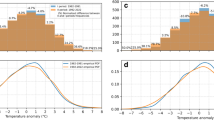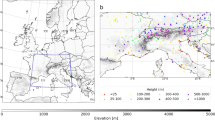Abstract
Climatic trends in observed and reanalysis data 1980–2014 are mapped to describe spatial structure in the central Caribbean and for guidance on future conditions. Surface air temperatures averaged over the study area 16–22°N, 80–68°W exhibit trends of + .02°C/year, that relate to radiative forcing by greenhouse gases and changes in atmospheric subsidence. Rainfall trends for the Antilles Islands are weakly upward around the Windward Passage 18–20.5°N, 78–73°W and downward to the east 18–20°N, 72–68°W. Spatial trends in air temperatures exhibit a steeper increase over the islands and away from the Windward Passage. Trends in satellite vegetation fraction are upward along the coast and coincide with rising latent heat flux especially west of Hispaniola. An accelerating Hadley circulation exhibits subsidence, warming and drying above 850 hPa. Near the surface, there is a trend of northeasterly winds channeled through the Windward Passage and increased moisture benefiting shallow convection. The research uncovers mesoscale structure in climate change through interaction of wind and rainfall trends.




Similar content being viewed by others
References
Adler RF, Huffman GJ, Chang A, Ferraro R, Xie P-P, Janowiak J, Rudolf B, Schneider U, Curtis S, Bolvin D, Gruber A, Susskind J, Arkin P, Nelkin E (2003) The version 2 Global Precipitation Climatology Project (GPCP) monthly precipitation analysis (1979-present). J Hydrometeorol 4:1147–1167
Angeles ME, Gonzalez JE, Erickson DJ, Hernández JL (2007) Predictions of future climate change in the Caribbean region using global general circulation models. Int J Climatol 27:555–569
Bamber JL, Riccardo EM, Riva BL, Vermeersen A, LeBrocq AM (2009) Reassessment of the potential sea-level rise from a collapse of the West Antarctic Ice Sheet. Science 324:901–903
Bosilovich MG, Kennedy J, Dee D, Allan R, O’Neill A (2013) On the reprocessing and reanalysis of observations for climate, in climate science for serving society: research, model and prediction priorities. In: G Asrar, J Hurrell (eds) Springer, pp 51–71
Campbell JD, Taylor MA, Stephenson TS, Watson RA, Whyte FS (2010) Future climate of the Caribbean from a regional climate model. Int J Climatol 31:1866–1878. https://doi.org/10.1002/joc.2200
Carton JA, Giese BS (2008) A reanalysis of ocean climate using simple ocean data assimilation (SODA). Mon Weather Rev 136:2999–3017
Chassignet EP, Chassignet E, Hurlburt H, Joseph Metzger E, Smedstad O, Cummings J, Halliwell G, Bleck R, Baraille R, Wallcraft A, Lozano C, Tolman H, Srinivasan A, Hankin S, Cornillon P, Weisberg R, Barth A, He R, Werner F, Wilkin J (2009) US GODAE: Global ocean prediction with the hybrid coordinate ocean model (Hycom). Oceanography 22:64–75
Chen AA, Taylor M (2002) Investigating the link between early season Caribbean rainfall and the El Niño+1 year. Int J Climatol 22:87–106
Christensen JH et al (2007) Regional climate projections. In: Solomon S et al (eds) Climate change 2007: the physical science basis. WG I contribution to 4th assessment report IPCC. Cambridge University Press, New York 996 pp
Dee DP et al (2011) The ERA-interim reanalysis: configuration and performance of the data assimilation system. Q J R Meteorol Soc 13:553–597
Doherty, R.M., M. Hulme, and, C.G. Jones, 1999: A gridded reconstruction of land and ocean precipitation for extended tropics from 1974-1994. Int J Climatol, 19, 119–142
Funk CC et al (2014) A quasi-global precipitation time series for drought monitoring. U.S. Geological Survey Data Series 832, 4 pp. https://doi.org/10.3133/ds832
Giannini A, Kushnir Y, Cane MA (2000) Interannual variability of Caribbean rainfall, ENSO, and the Atlantic Ocean. J Clim 13:297–311
Hall TC, Sealy AM, Stephenson TS, Kusunoki S, Taylor MA, Chen AA, Kitoh A (2012) Future climate of the Caribbean from a super-high-resolution atmospheric general circulation model. Theor Appl Climatol. https://doi.org/10.1007/s00704-012-0779-7
Hansen J, Sato M, Ruedy R (1997) Radiative forcing and climate response. J Geophys Res 102:6831–6864
Houghton JT, Ding Y, Griggs DJ, Noguer M, VanderLinden PJ, Xiaso D (2001) Climate change 2001. The scientific basis. Cambridge University Press, Cambridge 944 pp
Hu A, Meehl GA, Han W, Yin J (2009) Transient response of the MOC and climate to potential melting of the Greenland Ice Sheet in the 21st century. Geophys Res Lett 36:L10707. https://doi.org/10.1029/2009GL037998
Hulme M, Osborn TJ, Johns TC (1998) Precipitation sensitivity to global warming: comparison of observations with HadCM2 simulations. Geophys Res Lett 25:3379–3382
Hurrell SW, SJ Brown, KE Trenberth and JR Christy (2000) Comparison of tropospheric temperatures from radiosondes and satellites: 1979–98. Bull Amer Meteor Soc 81:2165–2178
IPCC (2013) Summary for policymakers. In: Stocker TF et al (eds) Climate change 2013 the physical science basis. Contribution of WG I to 6th assessment report of IPCC. Cambridge University Press, New York
Jones PD et al (2001) Adjusting for sampling density in grid box land and ocean surface temperature time series. J Geophys Res 106:3371–3380
Jones PD et al (2015) Long-term trends in precipitation and temperature across the Caribbean. Int J Climatol. https://doi.org/10.1002/joc.4557
Joyce RJ, Janowiak JE, Arkin PA, Xie PP (2004) CMORPH: a method that produces global precipitation estimates from passive microwave and infrared data at high spatial and temporal resolution. J Hydrometeorol 5:487–503
Jury MR (2011a) Long term variability and trends in the Caribbean Sea. Int J Oceanogr. https://doi.org/10.1155/2011/465810
Jury MR (2011b) Representation of the Caribbean mean diurnal cycle in observation, reanalysis, and CMIP3 model datasets. Theor Appl Climatol 107:313–324
Jury MR, Chiao S (2011) Meso-circulation associated with summer convection over the central Antilles. Earth Interact 15:1–19
Jury MR, Malmgren BA (2011) Joint-modes of climate variability across the inter-Americas. Int J Climatol 32:1033–1046. https://doi.org/10.1002/joc.2324
Jury MR, Whitehall K (2009) Warming of an elevated layer over Africa. Clim Chang. https://doi.org/10.1007/s10584-009-9657-4
Jury MR, Winter A (2009) Warming of an elevated layer over the Caribbean. Clim Chang. https://doi.org/10.1007/s10584-009-9658-3
Jury MR, Winter A, and Malmgren B (2007) Sub-regional precipitation climate of the Caribbean and relationships with ENSO and NAO. J Geophys Res 112: D16107. https://doi.org/10.1029/2006JD007541
Kanamitsu M et al (2002) NCEP–DOE AMIP-II reanalysis (R-2). Bull Am Meteorol Soc 83:1631–1643
Karmalkar AV et al (2013) A review of observed and projected changes in climate for the islands in the Caribbean. Atmósfera 26:283–309
Lacis AA, Webbles DJ, Logan JA (1990) Radiative forcing by changes in the vertical distribution of ozone. J Geophys Res 95:9971–9981
Lu J, Vecchi GA, Reichler T (2007) Expansion of the Hadley cell under global warming. Geophys Res Lett 34:L06805. https://doi.org/10.1029/2006GL028443
Martin E, Schumacher C (2011) The Caribbean low-level jet and its relationship with precipitation in IPCC AR4 models. J Clim 24:5935–5950
Martis A, vanOldenborgh GJ, Burgers G (2002) Predicting rainfall in the Dutch Caribbean – more than El Niño. Int J Climatol 22:1219–1234
McSweeney C, New M, Lizcano G (2008) UNDP Climate Change Country Profiles. Geography and Environment, Univ. Oxford Internal Rep. 164–191
Meehl GA et al (2007) The WCRP CMIP3 multimodel dataset: a new era in climate change research. Bull Am Meteorol Soc 88:383–394
Monterey G and Levitus S (1997) Seasonal variability of mixed layer depth for the world ocean. NOAA Atlas NESDIS 14, U.S. Gov. Printing Office, Wash., D.C., 96 pp
Neelin JD, Minnich M, Su H, Meyerson H, Holloway CE (2006) Tropical drying trends in global warming models and observations. Proc Natl Acad Sci 103:166110–166115
Perez CR, Jury MR (2013) Spatial and temporal analysis of climate change in Hispañola. Theor Appl Climatol 113:213–224
Peterson TC et al (2002) Recent changes in climate extremes in the Caribbean region. J Geophys Res 107:4601. https://doi.org/10.1029/2002/JD002251
Ramanathan V, Cicerone R, Singh H, Kiehl J (1985) Trace gas trend and their potential role in climate change. J Geophys Res 90:5547–5566
Rausher S, Giorgi F, Noah D, Anji S (2008) Extension and intensification of the meso-American mid-summer drought in the twenty-first century. Clim Dyn 31:551–571
Ryu J-H, Hayhoe K (2013) Understanding the sources of Caribbean precipitation biases in CMIP3 and CMIP5 simulations. Clim Dyn 42:1–20
Simpson MC et al (2010) Quantification and magnitude of losses and damages resulting from the impacts of climate change: modelling the transformational impacts and costs of sea level rise in the Caribbean (summary document). UNDP, Barbados
Singh B (1997) Climate changes in the greater and southern Caribbean. Int J Climatol 17:1093–1114
Smith TM et al (2008) Improvements to NOAA’s historical merged land-ocean surface temperature analysis 1880-2006. J Clim 21:2283–2293
Stephenson TS et al (2014) Changes in extreme temperature and precipitation in the Caribbean region, 1961–2010. Int J Climatol. https://doi.org/10.1002/joc.3889
Stocker TF et al (2013) Technical summary. In: Climate change 2013 the physical science basis. WG I contribution to 5th IPCC assessment report. Cambridge University Press, New York, pp 33–115
Taylor KE, Stouffer RJ, Meehl GA (2012a) An overview of CMIP5 and the experiment design. Bull Am Meteorol Soc 93:485–498
Taylor MA, Whyte FS, Stephenson TS, Campbell JD (2012b) Why dry? Investigating the future evolution of the Caribbean low level jet to explain projected Caribbean drying. Int J Climatol 33:784–792. https://doi.org/10.1002/joc.3461
Tokinaga H, Xie S-P (2011) Wave- and anemometer-based sea surface wind (WASWind) for climate change analysis. J Clim 24:267–285
Tucker CJ et al (2005) An extended AVHRR 8 km NDVI dataset compatible with MODIS and SPOT vegetation data. Int J Remote Sens 26:4485–4498
Wang C, Lee S-K, Enfield DB (2008) Atlantic warm pool as a link between Atlantic multidecadal oscillation and Atlantic tropical cyclone activity. Geochem Geophys Geosyst 9:Q05V03. https://doi.org/10.1029/2007GC001809
Yukimoto S, Noda A, Uchiyama T, Kusunoki S, Kitoh A (2006) Climate changes of the twentieth through twenty-first centuries simulated by the MRI-CGCM2.3. Meteorol Geophys 56:9–24
Author information
Authors and Affiliations
Corresponding author
Appendix. Temporal projections
Appendix. Temporal projections
Climate projections from the CMIP5 MRI model using the mid-range rcp6.0 W/m2 scenario (Yukimoto et al. 2006. Taylor et al. 2012a, b, Perez and Jury 2013) were evaluated over the period 1980–2050 and placed in context using NCDC temperature (Smith et al. 2008), GPCP rainfall (Adler et al. 2003), and NASA vegetation fraction. Annual area averages (16–22° N, 80–68° W) were calculated, and the linear slope and r2 fit were determined. Observed and projected temperature trends (Fig. 5a) were consistent: .0134 °C/year versus .0145 °C/year, r2 fit increased from 0.39 to 0.80. Rainfall showed no trend (Fig. 5b) and multi-year variability continued, in contrast to findings of Jones et al. (2015) that indicate variability overtaken by drying. The land vegetation fraction and projected area-average latent heat flux had upward trends (Fig. 5c): + .0019/year, r2 = 0.63 versus LHF + .0027 mm/day/year, r2 = 0.88; evaporation is accelerating. The annual cycle of rainfall for all vs land areas around the Windward Passaage (Fig. 5d) has bi-modal character with land > sea. There is a drying trend over the islands ~ 1 mm/day in Jun–Aug months, possibly related to divergent winds east of the Windward Passage (cf Fig. 3a). Other CMIP outputs are reviewed in Ryu and Hayhoe (2013).
Time series of CMIP5 MRI projected and observed: a air temperature anomalies, b rainfall anomalies, and c vegetation fraction and latent heat flux. Linear trend and fit are given; all averaged over the Windward Passage area. d Projected “all” and “land” annual cycle of rainfall 1980–2010 (past) and 2020–2050 (future)
Rights and permissions
About this article
Cite this article
Jury, M.R. The pattern of climate change around the Windward Passage. Theor Appl Climatol 137, 1149–1157 (2019). https://doi.org/10.1007/s00704-018-2658-3
Received:
Accepted:
Published:
Issue Date:
DOI: https://doi.org/10.1007/s00704-018-2658-3





